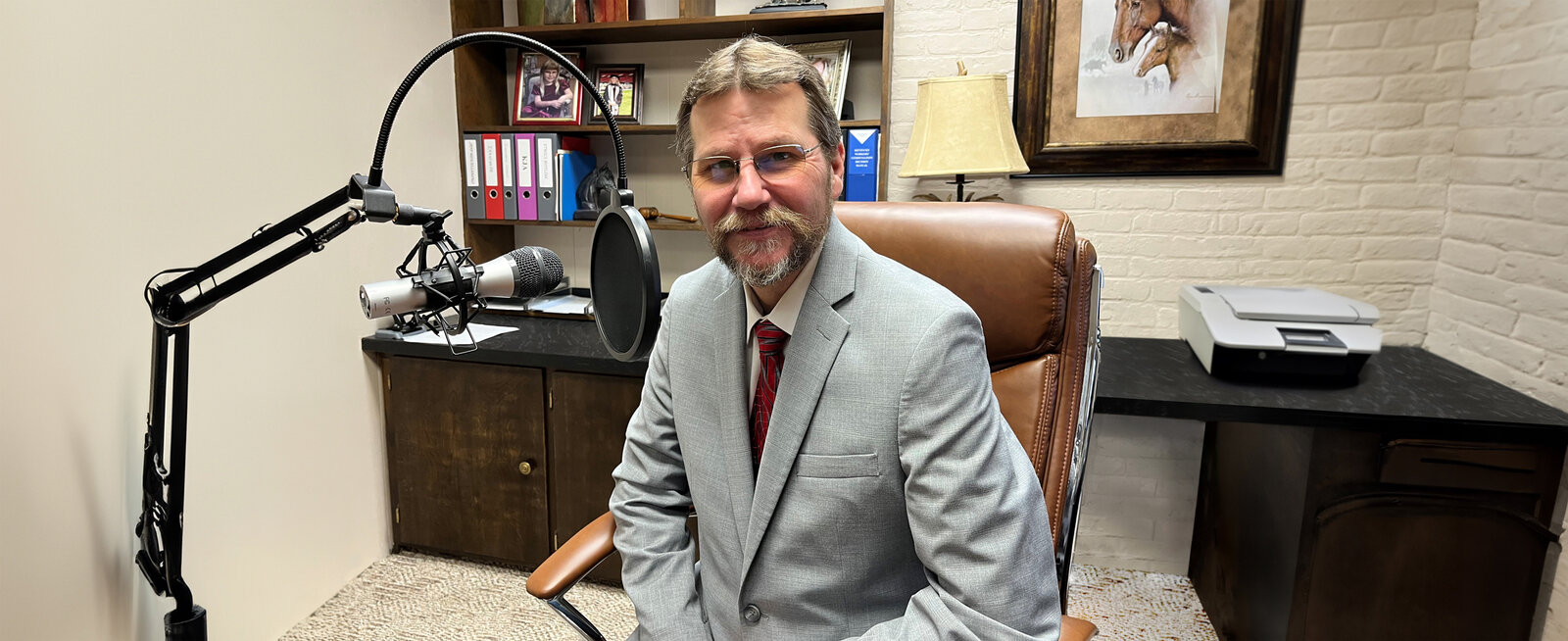Episode 59: Calloway County attorney Jeff Roberts has over 30 years of experience handling car wreck cases. If he can establish negligence, there settlement or jury verdict typically comes down to the insurance carried by the at-fault driver. In this episode, Jeff will help you to understand insurance coverage issues and why each of them is important. You can use this information to be sure you have the proper types and amounts of insurance to protect you and your family.
Identifying the Available Sources of Recovery
When Jeff takes on a client injured in a motor vehicle collision, one of the first steps he takes is to begin identifying the various sources of insurance, which might be available to cover the damages. Typical damages are bodily injury, pain and suffering and property damage.
As Jeff explains, when the wreck happens, the damages are basically set. However, there can always be additional circumstances that increase the damages, such as multiple surgeries or other medical complications, including a potential wrongful death claim should the injured person eventually die as a result of the injuries sustained in the automobile collision.
Jeff has a duty to try to maximize the recovery on behalf of his clients. Looking at the available insurance policies that may apply is an important part of the process.
Jeff goes on to say that regardless of whether you’re the victim or the at-fault driver, you should be aware of the various types of insurance coverages. You want to make sure you and your family are protected.
Kentucky State Minimum Coverage
From an automobile and truck standpoint, Jeff explains Kentucky is a mandatory insurance state. You are required to have certain coverage on your vehicle. Interestingly, if your state does not require you to have insurance, if you drive in Kentucky, you are required to meet the state minimum coverages. You could be fined for not having it.
Kentucky requires liability bodily injury coverage, liability property damage coverage, PIP (“no-fault”) coverage and uninsured motorist coverage (“UM”). You can opt out of UM coverage by signing a waiver.
The limits required for these coverages haven’t been changed since the mid-1970s. This can present a problem, given the cost of medical treatment and automobile-related repairs or replacement. The minimum bodily injury limit is $25,000. The minimum property damage limit is $25,000. The minimum uninsured motorist limit is $25,000. The minimum PIP limit is $10,000.
Liability Bodily Injury Insurance
If you’re at-fault, your insurance will cover the medical expenses for the other driver and passengers. The policy limits would be $25,000, using the above state minimum coverage. Your policy may show 2 different numbers, such as 25/50 or 50/100. This means it covers up to $25,000 for a single person or up to $50,000 total for a single wreck. The same logic applies to the 50/100. Jeff comments that same also holds true for uninsured motorist coverage, based on the specific limits for that policy, although it’s your own policy, not the at-fault driver’s policy.
Uninsured Motorist Coverage
This covers the person who did not cause the wreck, assuming the at-fault driver is not insured. UM coverage is generally for lost wages, impaired capacity to earn, medical expenses, as well as pain and suffering.
Liability Property Damage Insurance
Again, if you’re the at-fault driver this coverage would be paid to the other driver. It covers their property damage up to the policy limit. Again, in Kentucky, the state minimum is $25,000. Unfortunately, most cars are more expensive than $25,000, today. If the vehicle is totaled, the at-fault driver with the state minimum coverage may not cover the entire damage.
Jeff explains that one type of coverage cannot be “stacked” to pay for a different category.
Under Insured Motorist Coverage
This coverage is there to protect you, similarly to Uninsured Motorist Coverage. However, with Under Insured Motorist Coverage (“UIM”), the at-fault driver had some insurance, but it may not have been enough to pay for your additional medical bills. Your own UIM policy would attempt to make up the difference between the at-fault driver’s policy limit and the actual damages you incurred as a result of the car wreck. UIM does not pay for property damage.
It’s important to understand that Kentucky has specific statutes that prohibit your insurance company from raising your rates because you filed an uninsured motorists (UM) or an under insured motorist (UIM) claim.
UIM coverage is not mandatory in Kentucky, but Jeff strongly recommends having it.
PIP (“no-fault”) Insurance
No-fault insurance, also called Personal Injury Protection (PIP) or Basic Reparations Benefits is required in Kentucky. Kentucky is a no-fault state. This means you have a minimum of $10,000 for you and each of your passengers, individually, to cover medical expenses and lost wages if involved in a traffic accident.
Negligence doesn’t have to be proven before these funds are made available. The vehicle you’re in pays this coverage, regardless of which driver is at fault.
If you are a pedestrian (including a bicyclist), the vehicle that makes contact with you will pay your PIP benefits.
It’s important to note that PIP coverage for motorcyclists is NOT automatic or mandatory. You have to purchase this insurance coverage in Kentucky. This is a major difference to understand.
Jeff mentions you could consider “added reparations benefits” which is a way to increase your PIP coverage, beyond the $10,000. This could be a very good way to handle medical expenses related to the car or motorcycle accident, especially if you don’t have good insurance or a short-term disability policy.
The Myth of “Full Coverage”
This doesn’t actually exist. It definitely doesn’t fully cover you. It commonly provides for all of the required, state coverages. However, the optional coverages, such as UIM, Comprehensive Coverage and Collision Coverage must be added.
Comprehensive Coverage would come into play if you were driving and suddenly hit a deer, for instance. Collision Coverage is there to pay for your property damage, if you’re at fault in the car wreck.
Full Coverage typically does not address the policy limits of the particular types of insurance. Jeff explains that if your policies are only for the state minimum levels, and you cause a wreck that results in significantly more damages than your policy limits, the attorneys for the injured victims could go after your assets, after the policy limits have been paid.
It may be time to have a discussion with your insurance agent. Be sure to question specific coverages that may not apply to you, but are included in your current policy. This may be the time to consider increasing the policy limits of your various coverage. At the same time, you may want to shop around to see if you can get a better price for your automobile insurance.
As Jeff states, “Full coverage but minimum limits? You’re underinsured.”
Insurance Issues for Homeowners
Jeff has handle various premises liability claims involving someone who was injured in someone else’s home or on their property.
You should review your policy to highlight insurance coverage issues. Do it from liability perspective. What are your liability limits? Liability coverage is to cover someone else who sustains an injury on your property because of your negligence.
Another issue to consider is the amount of medical pay coverage (“Med-Pay”). This covers someone who gets injured on your property, regardless of who was negligent. Med-Pay does not apply to the homeowner or someone who lives with you.
Jeff has spoken to many people about filing a lawsuit because they were hurt on someone’s property and the homeowner didn’t want to pay for the doctor bills. Maybe they didn’t have significant Med-Pay coverage, or simply didn’t understand their liability. This could result in a very expensive legal situation for the homeowner.
Jeff recommends checking your policy and coverages from periodically. There’s a chance that you’ve made improvements to your house or property, but forgot to increase your insurance coverage.
At the same time, inflation has caused the price of materials and labor to increase, so your coverage limits from 5 years ago may not go as far as they once did.
It’s also possible that your property has increased in value over time. If you failed to increase your insurance limits to allow for the increase in value, you may be significantly under insured.
An area people often overlook is when they have certain items included on their homeowner’s policy, but have not considered increasing the amount of coverage for the increased value of the item(s).
Examine your policy to identify additional premiums you may be paying for items you no longer own. This may be a way to save some money on your homeowner’s insurance.
It’s always important to take time to thoroughly review of your policies and have your agent discuss any insurance coverage issues.
Jeff Roberts Represents Injured Clients Throughout Kentucky
With offices located in Calloway County and now Christian County, Jeff has a history of representing personal injury clients, workers’ compensation clients and social security disability clients across the state. He’s represented clients from Paducah, Bowling Green, Louisville, Covington, Whitesville and many other Kentucky locations. He’s not just a Western Kentucky injury attorney.
We hope you found this episode insightful and helpful. Thank you for listening!
Is It Time to Speak with an Attorney Who Knows Car and Motorcycle Accidents Cases?
The office phone number is (270) 753-0053 or toll free at 800-844-5108. For more information, visit www.JeffRobertsLaw.com. This podcast is meant to provide information and is not legal advice. Jeff’s principal office is located at 509 Main Street, Murray, Kentucky. Co-host Jim Ray is a non-attorney spokesperson. This is an advertisement.





